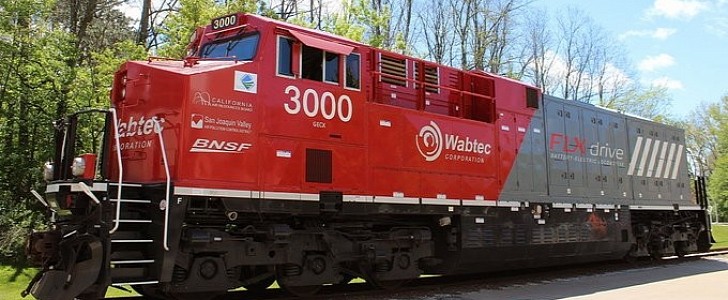I don’t know about you, but it seems to me that we are on a “zero-emissions” global race and everybody in the automotive industry is hoping on board. It may not look as exciting as EVs, electric 2-wheelers or even electric boats, but battery-powered locomotives are also an important part of this massive trend.
As freight trucks are on their journey to becoming more environmentally-friendly, so are freight locomotives, except that the process seems to be slower in their case. A fully battery-powered freight locomotive, the first of its kind in the world, has just been successfully tested in California.
Called FLXdrive, this pioneering locomotive is the result of a collaboration between Wabtec (rail equipment provider), BNSF Railway (the largest railroad in the U.S.) and the San Joaquin Valley Air Pollution Control District, in California. They were awarded a $22.6 million grant, from the California Air Resource Board, in order to develop and test the first battery-powered locomotive.
The 430,000-pound FLXdrive uses no less than 18,000 lithium-ion battery cells, with a total capacity of 2.4 MWh. Plus, it features a cruise control system, programmed through artificial intelligence. This is how the Trip Optimizer system is able to adapt to the twists along the track and choose the most energy-efficient response.
For this first test, Wabtec’s locomotive traveled across 13,320 miles (21,430 km), in San Joaquin Valley. This region was chosen because it is classified as a non-attainment area, which means that it’s so polluted that its air quality is below national standards. FLXdrive charged at the rail yard, and then recharged through regenerative braking, on the way to its destination.
The result was an 11% reduction in the entire train’s fuel consumption and carbon emissions. It might not seem like a lot, but it does mean 6,200 gallons (23,470 liters) of diesel fuel that was saved and 69 tons of CO2 emissions that were cut.
And this is just the beginning. A second-generation locomotive will be able to further reduce fuel consumption and carbon emissions by 30%. According to Wabtec, a fleet of these second-generation FLXdrives could being to be commercialized over the next years.
Called FLXdrive, this pioneering locomotive is the result of a collaboration between Wabtec (rail equipment provider), BNSF Railway (the largest railroad in the U.S.) and the San Joaquin Valley Air Pollution Control District, in California. They were awarded a $22.6 million grant, from the California Air Resource Board, in order to develop and test the first battery-powered locomotive.
The 430,000-pound FLXdrive uses no less than 18,000 lithium-ion battery cells, with a total capacity of 2.4 MWh. Plus, it features a cruise control system, programmed through artificial intelligence. This is how the Trip Optimizer system is able to adapt to the twists along the track and choose the most energy-efficient response.
For this first test, Wabtec’s locomotive traveled across 13,320 miles (21,430 km), in San Joaquin Valley. This region was chosen because it is classified as a non-attainment area, which means that it’s so polluted that its air quality is below national standards. FLXdrive charged at the rail yard, and then recharged through regenerative braking, on the way to its destination.
The result was an 11% reduction in the entire train’s fuel consumption and carbon emissions. It might not seem like a lot, but it does mean 6,200 gallons (23,470 liters) of diesel fuel that was saved and 69 tons of CO2 emissions that were cut.
And this is just the beginning. A second-generation locomotive will be able to further reduce fuel consumption and carbon emissions by 30%. According to Wabtec, a fleet of these second-generation FLXdrives could being to be commercialized over the next years.
She crossed the finish line in championship fashion! The FLXdrive Battery Electric Locomotive demonstrated her power in an electrifying test of endurance to drive down emissions. #Freight2030 #Sustainability #Decarbonization #Innovation #WeAreWabtec pic.twitter.com/zJ0VFrsGYx
— Wabtec Corporation (@WabtecCorp) May 13, 2021

